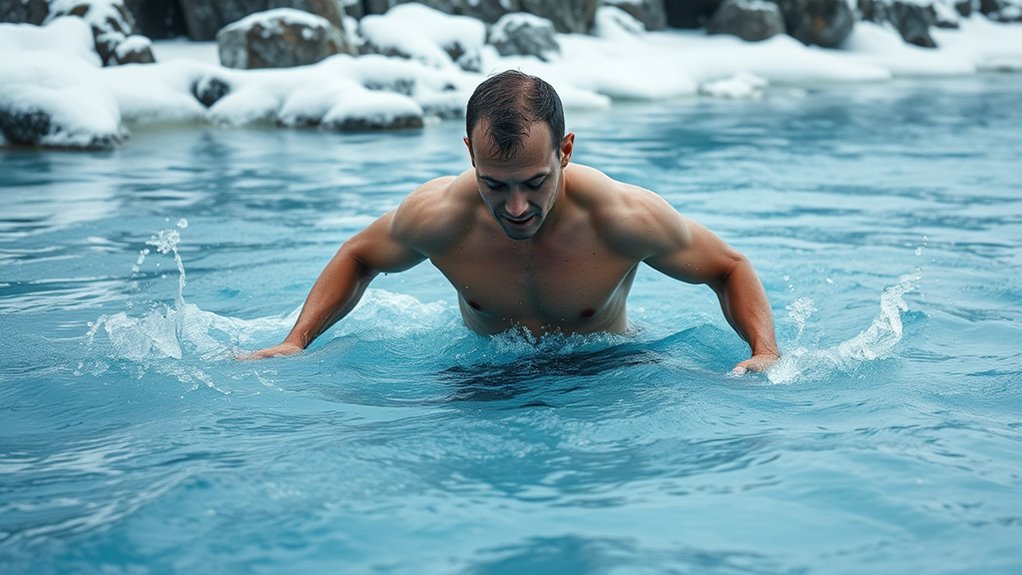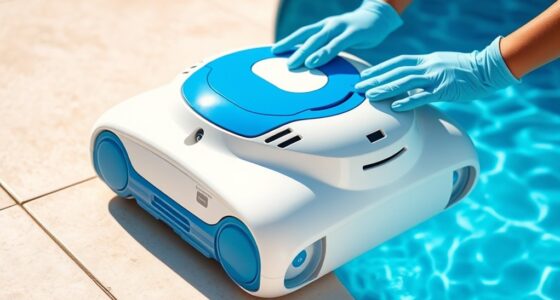When you immerse in cold water, your body reacts quickly by constricting blood vessels, increasing your heart rate, and causing shallow breathing, all to protect crucial organs and prevent hypothermia. These responses can strain your cardiovascular system and require proper precautions. Gradual exposure, controlled breathing, and listening to your body help manage these effects effectively. Want to understand how to safely navigate these responses? Keep going to discover essential tips for safe cold-water immersion.
Key Takeaways
- Cold-water immersion triggers the shock response, causing rapid heart rate, blood vessel constriction, and shallow breathing.
- The body activates vasoconstriction and shivering to conserve heat and maintain core temperature.
- Gradual exposure and proper breathing techniques help manage physiological stress and reduce risks.
- Awareness of body’s signals prevents overexertion and adverse effects during immersion.
- Safety measures include monitoring responses and easing into cold water to allow physiological adaptation.

Have you ever wondered why athletes and wellness enthusiasts plunge into cold water? It’s not just for a quick thrill; there’s a fascinating physiological response behind it. When you suddenly immerse yourself in cold water, your body reacts intensely through what’s called a shock response. This immediate reaction causes your blood vessels to constrict, your heart rate to spike, and your breathing to become rapid and shallow. This response is your body’s way of protecting itself from the sudden drop in temperature, but it can also be dangerous if not managed properly. The shock response is a natural part of how your body tries to maintain stability and protect essential organs when faced with cold stimuli.
Central to this process are your thermoregulation mechanisms—your body’s built-in systems for maintaining a stable core temperature. When you’re exposed to cold water, sensors in your skin detect the temperature drop and send signals to your brain. In response, your body activates several thermoregulatory processes. Initially, your blood vessels near your skin constrict to reduce heat loss, directing blood flow toward your core to keep vital organs warm. This vasoconstriction is indispensable because it prevents rapid cooling of your internal organs, but it also increases your blood pressure and strain on your heart. Simultaneously, your muscles may begin to shiver involuntarily, generating heat through rapid contractions, and your metabolic rate may increase to produce additional warmth. Recycled materials are often used in eco-friendly planters, reflecting sustainability efforts similar to how your body adapts to cold by optimizing internal resources.
Understanding these mechanisms helps you realize why cold-water immersion isn’t just a simple swim; it’s a complex physiological challenge. The shock response and thermoregulatory adjustments occur so quickly that your body is fighting to stabilize itself immediately upon immersion. While some people seek out cold water for its potential benefits—like improved circulation, reduced inflammation, and mental resilience—it’s essential to recognize how intense and potentially risky these responses can be. If you’re new to cold-water immersion, easing into the experience gradually allows your body to adapt more safely. Proper breathing techniques can help manage the shock response, preventing hyperventilation and reducing the risk of panic. Always pay attention to your body’s signals and never push beyond your limits.
Frequently Asked Questions
Can Cold-Water Immersion Improve Athletic Recovery Beyond Traditional Methods?
Cold-water immersion can enhance your athletic recovery by promoting muscle repair and reducing inflammation. It works by constricting blood vessels, which decreases swelling, and then dilates them when you exit, helping flush out metabolic waste. This process accelerates healing and alleviates soreness more effectively than traditional methods like rest or stretching. If used correctly, cold-water immersion can be a valuable tool to boost your recovery and get you back to peak performance faster.
What Are the Long-Term Effects of Repeated Cold-Water Immersion Sessions?
Repeated cold-water immersion can lead to increased adaptation tolerance, meaning your body becomes better at handling cold stress over time. However, it may also have a metabolic impact, potentially reducing inflammation and muscle soreness long-term. While these effects can aid recovery, overdoing it might impair your body’s natural responses. You should balance immersion sessions to maximize benefits without hindering your overall adaptation process.
Is Cold-Water Immersion Safe for Individuals With Heart Conditions?
You should be cautious if you have heart conditions, as cold-water immersion can increase heart risk due to sudden shock and blood pressure spikes. Always consult your healthcare provider before trying it, and follow safety precautions like limiting immersion time and monitoring your response. If your doctor approves, start slowly to minimize risks. Prioritize safety to guarantee cold-water immersion benefits without compromising your heart health.
How Does Cold-Water Immersion Affect Mental Health and Mood?
Imagine a gentle wave of calm washing over you—that’s how cold-water immersion can influence your mental health. It promotes mood regulation and offers potential mental health benefits by releasing endorphins and reducing stress hormones. You might find yourself feeling more energized and balanced afterward. While it’s not a cure-all, incorporating cold-water immersion thoughtfully can be a invigorating way to support your emotional well-being and boost your overall mood.
What Are the Best Protocols for Beginners to Start Cold-Water Immersion Safely?
To start cold-water immersion safely, you should focus on gradual adaptation and proper breathing techniques. Begin with short, controlled exposures—just a minute or two—and slowly increase duration over time. Practice deep, steady breaths to manage shock and stay relaxed. Always listen to your body, and consider consulting a professional. This approach helps you build tolerance safely while enjoying the mental and physical benefits of cold immersion.
Conclusion
Now that you understand the physiology and precautions of cold-water immersion, remember it’s not just a quick dip—it’s a powerful tool that can transform your resilience and recovery. Always prioritize safety, listen to your body, and never underestimate its strength or vulnerabilities. With proper care, you can harness the incredible benefits of cold-water immersion, turning what seems like a simple plunge into an awe-inspiring journey of endurance. Stay cautious, stay strong—you’re capable of more than you think.









